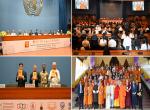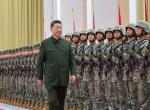Since the advent of independence, India has faced multitude of security challenges to its nationhood - both external and internal - and to its emergence as a deservingly significant player in the global order. Located in one of the most security and politically stressed regions of the world, and with some not so friendly neighbours, sharing nearly 7000 km of active international borders with seven nations, and a coastline spanning over 15000 km, India’s external security challenges are indeed formidable.
External challenges, in today’s increasingly troubled world, are by no means, exclusive in their orientation and impact. India’s internal security challenges, since decades, have also been pronouncedly sponsored and largely influenced by external machinations and subterfuge. However, it is also an accepted reality that, in recent times, external and internal threats do overlap seamlessly, apart from having multiplied in their intensity. Asymmetric and proxy wars are part of this new dynamic.
Over the last 70 years, India’s internal conflicts have ranged from Pakistani planned and supported insurgency, terrorism in Jammu and Kashmir and other Indian states, on-off-on internal unrest in some of India’s restive North Eastern (NE) states including Assam. Additionally, persistent efforts by Pakistan’s notorious spy agency, the Inter Services Intelligence (ISI), to foment communal trouble in Punjab and fan ‘Khalistani’ separatism, growing Naxal-Maoist Left Wing Extremism (LWE) threats in India’s hinterland, occasional sectarian, communal and language tensions, organized crime, money laundering, drug trafficking and now cyber driven crimes are the major internal security challenges confronting the Indian state. That since the last 2 years or so there has also been an upsurge in undesirable right wing extremist tendencies among some fringe elements inside India cannot be denied.
Common Factors Impacting Internal Security in India
Internal Security has many constituents and apart from external influences impacting it, there exist certain common factors which , historically, impinged its contours in the Indian context. Some of these are briefly discussed below.
India is home to countless faiths and sub faiths, cultures, castes, languages, regions, customs and its diversity, though uniquely beautiful, is indeed mind boggling. By conservative estimates, India is home to nearly 1660 languages (22 official) and dialects, nearly 3000 castes and sub-castes and virtually all known world religions - making India, indeed, a microcosm of the world. Unquestionably, India’s quintessential strength lies in this diversity, yet it also lends itself to major internal strife when provoked both from within or by external influences. The other nation born from the womb of Mother India since the parent nation’s violent partition in 1947, Pakistan, remains obsessively anti-India, grossly interfering in India’s internal affairs, fanning terrorism not only in Jammu & Kashmir (J&K) but in some other states also besides endeavouring to foist separatist feelings in some states of India, notably Punjab, Assam and in Naxal-Maoist afflicted regions. Pakistan’s continuing mischief inside India has adversely afflicted India’s internal security health - a factor which successive Indian governments have tended to underestimate despite wars with Pakistan in 1947-48, 1965, 1971 and the 1999 Kargil conflict .
Mediocre and insensitive governance in some states, especially those reeking in poverty and caste divides, also lend themselves to adverse internal conflicts within the nation. One of the major reasons leading to the alarming growth of LWE can be clearly attributed to this factor plaguing the nation apart from other aspects which lend themselves to the growth in LWE. Some politicians of varying ideological hues, pandering to their local vote banks indulge in electoral communal mobilisation by provoking imaginary divides, and stoke the fires of regionalism and separatism for temporary gains. That the people of India, through whom an invisible but an eternal strand symbolizing “Unity in Diversity” runs, have thwarted such devious ambitions of some politicians, time and again, is the saving grace.
India is now a youth- predominant nation, with over 65 percent of its population being under 35 years, which makes India into a very aspirational society. Millions of youth seek suitable employment, better living standards and a million dreams of theirs remain to be fulfilled. Any delays on such vital societal issues automatically contributes to economic and social frustrations which may lead to serious law and order problems besides youth finding their way to anti-national organizations including being influenced by international terror, smuggling networks et al.
The nuances of some of the serious internal security challenges and suggested national response to contain/manage/eliminate the internal conflicts within India are discussed briefly in the succeeding paragraphs.
Tackling Terrorism and Asymmetric Warfare
Since the last many decades, the phenomenon of terrorism has been an alarmingly spreading scourge of the modern age. One of the nations most affected by it has been India owing to its neighbour, Pakistan, having adopted terrorism as an extension of state policy to destabilize India. Not only in J&K but in other Indian states too, Pakistan has been zealously pursuing its anti-India, though myopic policies, of fomenting terror and unrest. As universally accepted after the 9/11 terror attacks in the US homeland, Pakistan is the fountainhead of most terror activities all over the world. However, now Pakistan is also suffering from intense terror activity perpetrated by those very ‘terror tanzeems’ it had raised to carry out its devious missions in neighbouring India and Afghanistan. Regrettably, Pakistan so far refuses to see reason with radicalism even permeating its official establishment while its sane civil society dwindles rapidly. Being a nuclear armed “failing state ” and coupled with rise in extremism makes Pakistan portend grave dangers for India. As we cannot expect to witness any major changes in Pakistan’s highly anti-India policies, it is crucially imperative for the Indian security establishment to factor in all security and terror scenarios which may afflict India from its perpetually belligerent western neighbor, now being substantially supported by its mentor, China. That Pakistan is a proxy for China, against India, brooks no explanation.
India’s security establishment will also now have to be alive to threats emanating from global Islamic jihadi outfits like Al Qaida, the Taliban in the Af-Pak region and now, alarmingly also from Daesh (Islamic State, or IS). Though Indian Muslim youth have remained unaffected from their vile propagandas, yet a few appear to have been affected within the nation and thus monitoring the movement of Muslim youth to the Middle East will have to be ensured. Intelligence agencies will have to keep under surveillance social media channels which try to influence/ recruit Muslim youth for terrorist activities as exemplified by ISIS websites. That these global jihadi outfits will collaborate their activities in the Indian subcontinent with Pakistani based so-called non-state actors like the Lashkar-e-Taiyabba, Jaish-e-Mohd, Hizb-ul-Mujaihdeen among many other terror ‘tanzeems’ in Pakistan, remains a distinct and dangerous possibility. As the security organs of the nation further streamline their functioning by synergetic endeavour and undertake better counter-terror capacity building, the central government has to speedily undertake additional measures to further strengthen our counter-terror and response mechanisms. All political parties in India must not politicize terror and a broad national consensus among all these parties must be reached on the national strategy and measures to be adopted to combat terror.
Secondly, in keeping with the nation’s resolve, India must prepare hard-hitting pre-emptive strike plans on terrorist infrastructure in POK and elsewhere in Pakistan, as and when required. Thirdly, India must determinedly endeavour to constantly improve its intelligence gathering, analysis and dissemination machinery - both HUMINT and TECHINT. Pakistan has to be made to realize, both through dialogue and, failing which, by speedy and effective kinetic responses, that terrorism against India will not pay. Stern action against all indigenous separatist leaders must be taken in case they continue to indulge in anti national or any form of secessionist activities. India must never be seen as a soft state, either by nations inimical to us and, importantly, by its own citizens. Importantly, India has to raise the costs for Pakistan whenever it indulges in mischief. Additionally, Pakistan has to be reminded that till date, India has not exploited Pakistan’s many fault-lines and India’s strategic restraint is not India’s permanent policy!
Combating Left Wing Extremism
The late Chinese Communist Party supremo, Mao Tse Tung, had succinctly observed that “Revolutionary Warfare is never confined within the bounds of military action because its purpose is to destroy an existing society and its institutions and to replace them with a completely new structure.” Among the internal security perils afflicting India, an alarmingly burgeoning is LWE commonly dubbed as the Naxal-Maoist threat. The LWE threat currently spans nearly 200 districts spread over 16 states with a wide swathe running across the centre of the Indian hinterland from the Nepal-Bihar border to the Karnataka and Kerala borders, in a south west orientation, commonly referred to as “The Red Corridor.” That these extremists have categorically proclaimed their objective to seize power in India by protracted war against the Indian state must be factored in by our security establishment. It is also well known that some of the areas in this “Red Corridor” are totally bereft of any governmental control and the LWE cadres refer to these as “liberated zones.” That Naxal-Maoists have cross border linkages with some neighbouring countries compounds the seriousness of this growing threat to India.
To rid the nation of LWE, it will be prudent to analyse the reasons for the growth of this scourge in India. These are, a lack of a clear cut national policy in combating indigenous insurgencies, poor intelligence capability at the grassroots level, ill equipped, under trained and poorly motivated police and central police organizations (CPOs). Above all, a total neglect of locally significant development programs in the LWE infested areas has contributed to the LWE problems. That most state governments have not implemented the various constitutional forest and land ceiling laws in these areas, enacted as early as in 1955, to safeguard the basic rights of tribals and the poor in rural areas has compounded and fuelled LWE. Thus, even some well educated youth have been drawn to this movement both on idealism and romantic notions of fighting for “the have-nots” against a cruel, corrupt and insensitive establishment.
One of the major causative factors for the growth of Naxal-Maoism is, that since independence, the fruits of development have not trickled down to the vast marginalized sections of Indian society. The ever growing disparities among the many layers in our society is seen by the poor as exploitative of their basic rights and such sentiments consequently get the underprivileged fall into the trap of the Naxal-Maoists. It is also a well known fact that some local leaders from different political dispensations maintain regular contacts with these militants, in their constituencies, to reap electoral benefits - something which is indeed shameful. Intelligence reports also indicate that LWE is slowly but surely spreading its tentacles to urban centres and the National Capital Region which has a fair amount of industry, trade unions etc. Thus unemployed youth in these areas and some industrial workers are being drawn to the LWE ideology - all these developments portend many future problems arising for the Indian state.
To merely attribute the spread of LWE in the backward regions of the country to exclusively socio-economic factors will be rather simplistic. Currently, the Maoists-Naxals have explicitly refused any peace parleys with the government and are indulging in the worst forms of violence not only against the police forces but also against innocent civilians and lower level state government functionaries. Thus the first priority of the state should be to take head-on these violent cadres of the Naxals-Maoists, eliminate/capture as many as possible without causing any heavy collateral damage to own civilians, villagers and also those among these extremists who wish to surrender to the state. The stated policy of “ Clear, Hold and Build” is eminently workable provided there is synergy in the will and action between the political and security elements of the nation at the state and central government levels, and, importantly among the contiguous states where Maoists generally escape to after committing their gruesome acts.
Efforts to sharpen our intelligence capabilities at the grassroots level in the LWE infested areas should be undertaken. Though it is the stated policy of the government not to employ the Army against own civilians, however, based on hard intelligence, small detachments of Special Forces could be used for executing lightning raids on the LWE leadership, in conjunction with employing helicopters and drones of the Air Force. Besides, the Indian Army should undertake training of CPOs and state police personnel in special operations tasks including in fighting through ambushes, night and stealth ops, bomb diffusing and IED neutralization missions.
The J&K Impasse
A major security challenge for the Indian establishment - with both distinct external and internal dimensions - is India’s eminently strategic state of J&K. Since J&K’s tumultuous accession to the Union of India in Oct 1947, the state’s relationship with its parent nation has been a roller coaster ride. Pakistan’s mischief in this state, continuing to date, resulting in four wars with India has shown to Pakistan that it cannot wrest J&K by force. Thus it crafted a well conceived strategy to destabilize India by fomenting terror, fanning separatism within the state and indulging in regular cease fire violations along the line of control and the international border . “ Bleeding India by a thousand cuts”, whose initiator was Gen Zia-ul-Haq, has metamorphosed as the stated Pak strategy.
Emotional integration of the people of the Kashmir Valley, especially the youth (distinct to population in the Jammu, Ladakh regions and Muslims other than Sunnis) with its parent nation constitutes a serious challenge. The current unrest in the Valley in which hundreds of youth including, regrettably, school children have been motivated to join the stone-pelters is a serious set-back to normalcy in the Valley. That the separatist leaders in the Hurriyat, on express orders from their masters in the Pakistani establishment, are spreading hate-India fervour amongst the Kashmiri youth needs to be tackled with firmness. These Hurriyat leaders must be arrested, as per the law, for their seditious activities and jailed outside the state. Comfortable house-arrests in Srinagar hardly deter them from their anti-national activities. The government must not allow them ever to meet their handlers in the Pak High Commission in New Delhi from where they get their instructions and financial doles. The security establishment in J&K must keep strict vigilance on the activities of all separatists and their Pak and ISIS flag waving cadres. As we permit democratic forms of dissent in the Valley, seditious activities have to be put down with an iron hand. The unique and first ever experiment of totally disparate parties, the People’s Democratic Party (PDP) and the Bhartiya Janata Party (BJP) in the state coalition government, must be made to succeed in the larger interests of the state and the nation. If Mehbooba Mufti’s government fails to arrest the deteriorating law and order situation in J&K, imposing President’s Rule for 6 months at least is the answer - sooner the better.
It must be unequivocally conveyed to Pakistan that J&K is an internal matter for India and the only issue left over by the baggage of history is the re-integration of POK/Gilgit Baltistan into J&K. India must talk to the Kashmiri ‘awam ( less the hard core Hurriyat leaders) and try and convince them that their future and Sufi lineage is safe within the inclusiveness of the Indian Union and not in a terror and radicalised state like Pakistan. We may also remember that in the past, whenever some Kashmiri separatist leaders have spoken of peace and moderation, they have been eliminated by Pak’s notorious ISI. The current state in the Kashmir Valley being rather grim requires the personal attention of PM Modi. An amalgam of firmness in re-establishing normalcy , followed by a healing touch with genuine and generous economic development packages for the state in the long run is the only answer. Meanwhile, our intelligence agencies must keep an eye on the increasing number of Wahabi oriented madrassas whose numbers are growing in the Valley fuelled by Saudi funds. India needs to send moderate Islamic leaders/ulemas to the Valley to pacify and put Kashmiri youth on the right track before Salafi radicalism overwhelms them.
The North East Conundrum
Often dubbed as a “distant frontier”, NE India’s psychological proximity to the parent nation has not diminished as much as it should have since 1947. NE India is the only expanse in South Asia which is geographically and strategically encircled by Nepal, China, Bhutan, Myanmar and Bangladesh. It is connected to the Indian hinterland by a narrow piece of land, namely the ‘Siliguri Corridor’ in West Bengal. The NE states account for 7.9 percent of the nation’s geographical area but only 3.8 percent of the national population. Close to 70 percent of this population resides in its largest state, Assam and the Brahmaputra Valley while the rest is in the other six states. This region has over 160 scheduled tribes and over 400 other tribal/sub tribal communities and groups with predominantly a rural economy.
Though most Indians, including of the establishment, refer by and large collectively to the seven states of the NE, it must be borne in mind that each of the states is different from each other with diversity not only in its ethnicity but security dynamics. Importantly, it is vital for the Indian state to introspect as to why, even after 60 years of prolonged efforts by New Delhi, conflict resolution has not been successful in this region except in Mizoram. Most NE scholars and security analysts opine that this strategic region suffers from a variety of deficits. These are a basic needs deficit, an infrastructure deficit, a resources deficit, a governance deficit and, importantly, a deficit of understanding between the region and the rest of the nation.
This region is ideal as a land bridge to the East Asian nations with immense yet untapped, economic potential. Notwithstanding being land, resource and water surplus, this region remains largely under-developed in spite of the fact that overall militancy has markedly declined in the region, though Assam, Nagaland and Manipur still remain of security concern. Another factor which plagues the return of normalcy to the region is the ongoing and formidable nexus between many insurgent groups and the drug mafias. In addition, China’s invisible presence and its linkages to some anti India insurgent groups, both in Nagaland (the NSCN-Khaplang faction) and Manipur also have contributed to political instability in the region.
Economic growth, effective and corrupt free governance and the restoration of law and order will go a long way in making India’s NE states grow to their full potential and bringing them fully into the national mainstream. As peace-talks and cease-fire agreements are negotiated by the Centre with various warring tribes from time to time, Indian Army, Assam Rifles and the local police must not dilute their counter-insurgency operations and further augment their intelligence capacity building in the entire NE region. The security forces must ensure that in the conduct of their missions, there is zero-tolerance by them as regards human rights violations are concerned. The Indian Army has always taken admirable care in this regard.
The youth of this region are uncommonly talented, physically robust and highly motivated and the Centre must reach out to them with commitment and sensitivity - both the region and the nation will benefit. In addition, as India now “Acts East”, this region’s economic development and India’s foreign policy engagements with the neighbourhood nations, in synergy, can prove substantially beneficial. Overall, the Centre must take determined out-of-the box political initiatives which go to address the many underlying socio-economic causes of our NE. We must open up sensitive channels of communication with the various insurgent groups to reach mutually agreeable solutions. With a friendly regime in Bangladesh, India must take advantage of the generally secure environment which prevails in the NE.
Conclusion: Intolerance and Communalism
A nation like India, with its immense diversity, as stated above in the introductory remarks of this article, is virtually a tinder-box waiting to be ignited if certain socio-economic-political imperatives are not fulfilled by either governments or society. Thus ethno-religious-ideological fault lines, which exist in India, have to be managed with a sense of fairness and balance for all sections of Indian society. Rough-riding the way of life of minorities leads to more alienation and consequently, more security problems for the nation. Indian leaders, of all political hues, must never lose sight of this vital cardinal and not only profess but practice inclusiveness and secularism. The Idea of India and its promise must never be sacrificed at the altar of sectarianism and for reaping electoral benefits. India’s internal security conflicts, of all shades, demands that.
By any benchmark, India today stands at the cusp of becoming a reckonable global power. Let us not miss the India moment. Let us, embellished by enlightened leadership, synergy amongst all institutions and the people, and propelled by determined implementation, re-energize the India Story as never before.
Image Source: https://www.thequint.com










Thank you.
Post new comment